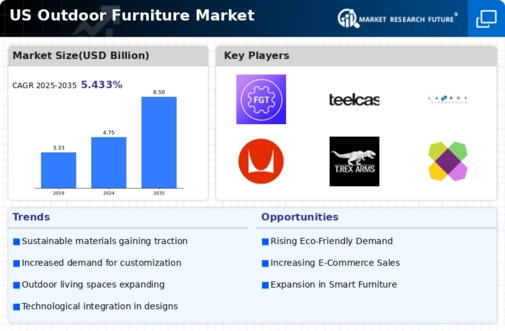Seasonal Demand Fluctuations
The outdoor furniture market experiences seasonal demand fluctuations, which significantly impact sales patterns. Typically, demand peaks during the spring and summer months when consumers are more inclined to utilize their outdoor spaces. Data indicates that sales in the outdoor furniture market can increase by as much as 30% during these peak seasons. Retailers often prepare for this surge by offering promotions and expanding inventory to meet consumer needs. However, the off-peak seasons present challenges, as sales tend to decline. Understanding these seasonal trends is crucial for businesses operating in the outdoor furniture market, as it allows them to strategize effectively and optimize their inventory management.
Growing Interest in Outdoor Activities
The outdoor furniture market is benefiting from a growing interest in outdoor activities among consumers. As more individuals seek to engage with nature and enjoy outdoor leisure, the demand for outdoor furniture has intensified. This trend is reflected in the increasing participation rates in outdoor recreational activities, which have seen a rise of approximately 15% over the past few years. Consequently, consumers are investing in outdoor furniture that enhances their outdoor experiences, such as patio sets, loungers, and dining furniture. The emphasis on creating comfortable and inviting outdoor spaces is likely to continue driving growth in the outdoor furniture market, as consumers prioritize their outdoor environments for relaxation and social gatherings.
Urbanization and Smaller Living Spaces
The outdoor furniture market is influenced by the ongoing trend of urbanization, which has led to an increase in smaller living spaces. As more people move to urban areas, the demand for compact and multifunctional outdoor furniture has surged. Urban dwellers are seeking solutions that maximize their limited outdoor space, prompting manufacturers to innovate with space-saving designs. This shift is evident in the rising popularity of balcony furniture and modular outdoor sets, which cater to the needs of city residents. The outdoor furniture market is likely to see continued growth as urbanization persists, with consumers increasingly looking for stylish yet practical outdoor furniture options that fit their lifestyle.
Sustainability and Eco-Friendly Products
The outdoor furniture market is increasingly influenced by consumer demand for sustainability and eco-friendly products. As environmental awareness grows, consumers are seeking outdoor furniture made from sustainable materials and processes. This shift is prompting manufacturers to innovate and offer products that align with eco-conscious values. Recent surveys indicate that approximately 60% of consumers are willing to pay a premium for sustainable outdoor furniture options. This trend not only reflects changing consumer preferences but also encourages companies within the outdoor furniture market to adopt more sustainable practices. As the market evolves, the emphasis on sustainability is likely to shape product offerings and influence purchasing decisions.
Increased Consumer Spending on Home Improvement
The outdoor furniture market is currently experiencing a surge in consumer spending on home improvement projects. As homeowners prioritize outdoor living spaces, expenditures on outdoor furniture have risen significantly. According to recent data, the home improvement market in the US is projected to reach approximately $500 billion by 2025, with outdoor furniture being a key segment. This trend indicates that consumers are willing to invest in quality outdoor furniture to enhance their living environments. The desire for aesthetically pleasing and functional outdoor spaces is driving demand, leading to a robust growth trajectory for the outdoor furniture market. As disposable income increases, consumers are likely to allocate more funds towards outdoor furniture, further propelling market expansion.



















Leave a Comment